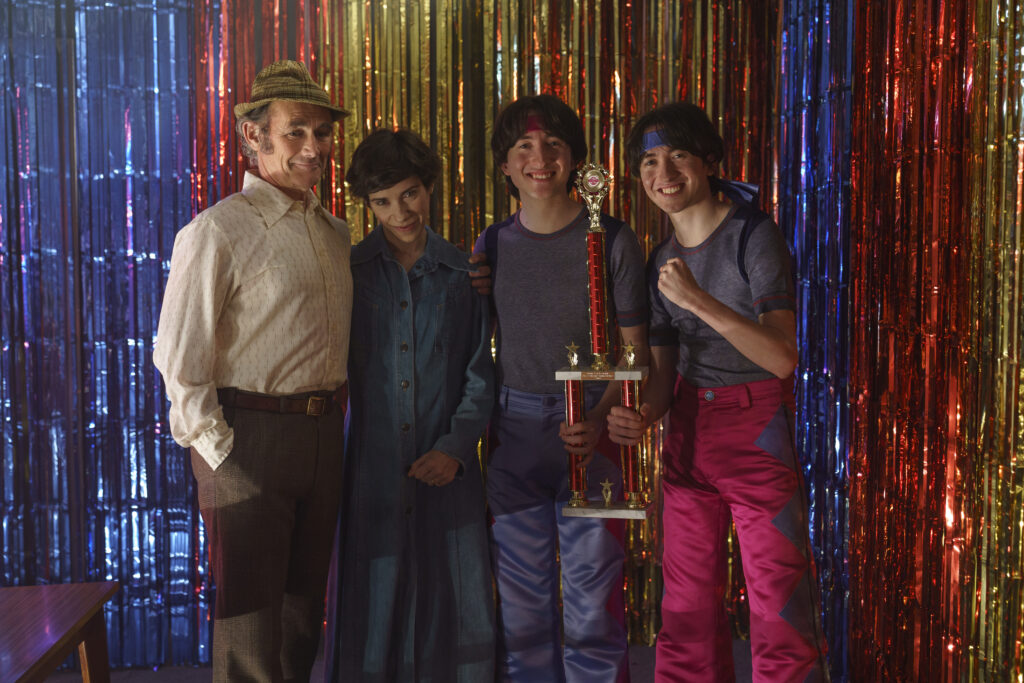June 2, 2022
by Carla Hay

Directed by Craig Roberts
Culture Representation: Taking place from the 1970s the mid-1980s, in various parts of England and briefly in the United States, the comedy/drama film “The Phantom of the Open” features a predominantly white cast of characters (with a few black people) representing the working-class and middle-class.
Culture Clash: Based on a true story, middle-aged golf enthusiast Maurice Flitcroft, who’s not very good at playing golf, cons his way into playing in various golf tournaments, often under various alias and disguises.
Culture Audience: “The Phantom of the Open” will appeal primarily to people who are fans of star Mark Rylance; British movies that blend comedy and drama; and well-done movies about underdog sports stories.

“The Phantom of the Open” tells the real-life story of British golf rogue Maurice Flitcroft with a charming mix of droll comedy and heartwarming drama. It’s not really an “against all odds” story but more of an “against elitist institutions” story. That’s because Flitcroft (who was not a talented golf player, by his own admission) knew he was unlikely to win any of the tournaments that he entered. He just wanted to prove that someone like himself deserved a chance of getting into these tournaments in the first place.
Directed by Craig Roberts and written by Simon Farnaby, “The Phantom of the Open” is a “root for the underdog” movie that’s led by a thoroughly entertaining performance by Mark Rylance as working-class Flitcroft, who schemed up different ways to enter golf tournaments, even when he was banned from them. The movie’s screenplay is based on the 2010 nonfiction book “The Phantom of the Open: Maurice Flitcroft, the World’s Worst Golfer,” written by Scott Murray and Farnaby. “The Phantom of the Open” movie touches on issues of social classes and the barriers involved in becoming a professional golfer. However, the story is mostly about the lengths that some people will go to if they’re very determined to pursue their dreams, and they come up against a system that wants to exclude them.
“The Phantom of the Open” takes place from the 1970s to the mid-1980s, an era before the Internet as we know it existed. It’s one of the reasons why Flitcroft was able to get away with a lot of his shenanigans when he disguised himself and used various aliases to enter golf tournaments where he was banned. It would be hard to imagine anyone being able to get away with the same things at professional golf tournaments now, when computer technology and information on the Internet can be used to verify people’s identities.
And that’s why the movie has a quaint tone to it, because it’s very much a story of a bygone era. “The Phantom of the Open,” which has voiceover narration from the Maurice Flitcroft character, begins by showing a brief introduction of his first claim to fame: He entered the British Open in 1976, and became notorious for being one of the worst-scoring players ever in that tournament.
The movie then segues into Maurice, who has an uncomplicated and soft-spoken personality, talking about his background in his hometown of Barrow-in-Furness, England. (He was born on November 23, 1929, and he died at the age of 77 on March 24, 2007.) At the time of Maurice’s golf antics, he worked as a crane operator/driver at a shipyard. Maurice says that he was raised to believe that working in the shipyard was his main job option, because it’s the same type of job that employed his father and Maurice’s paternal grandfather.
Maurice’s teenage years were interrupted during World War II, when he was sent to live with relatives in Scotland, because Maurice’s parents thought it would be safer for him to live in Scotland instead of England. (Tommy Fallon portrays an underage Maurice in these flashbacks.) After World War II ended, Maurice moved back to Barrow-in-Furness and started working as “shipyard fodder,” which he thought was his destiny.
While visiting an employment agency, Maurice met an agency employee named Jean Patterson (played by Sally Hawkins), a mild-mannered romantic, who eventually became his wife. The movie breezes through their sweet and simple whirlwind courtship, where Maurice tells single mother Jean that he is happy to raise her son Michael as his own son. At the time Maurice and Jean began dating and got married, Michael (played by Austin Griffin) was about 6 or 7 years old.
Jean is grateful for this acceptance because she’s often been shamed by other members of society for having a child out of wedlock. Jean tells Maurice that the teachers at Michael’s school would often call Michael a “bastard” and describe Jean as a “whore.” Michael’s biological father (who is not named in the movie) is described as a deadbeat dad who abandoned Jean and Michael and is no longer in their lives. Maurice and Jean get married and have two biological children together: identical twins named Gene and James. In her spare time, Jean runs a theater group for wayward and underprivileged children.
The movie then fast-forwards to 1975. Maurice is now 45 years old. Michael (played by Jake Davies) is now in his 20s. Twin brothers Gene (played by Christian Lees) and James (played by Jonah Lees) are in their late teens. Michael has a college degree and is working as a manager at the shipyard. Gene and James have become obsessed with disco dancing and are determined to win as many disco dancing contests as possible.
Maurice will soon have his own obsession: golf. While watching Tom Watson win the 1975 Open Championship on TV, Maurice becomes fascinated by the game. It’s Watson’s first major golf title. And it’s a transformative experience for Maurice, who soon begins to have fantasies of being a professional golfer. These dreams inspire Maurice to set a goal of winning the 1976 British Open.
It’s perhaps not a coincidence that Maurice starts thinking about becoming a golfer when he hears that there will be layoffs at the shipyard because the shipyard will becoming nationalized under the British government. Because of his age, Maurice assumes that he will be one of the laid-off employees who will be considered “redundant”—and not even having a son as a shipyard manager can save Maurice’s job. While bracing himself for possibly losing his shipyard job, Maurice becomes more and more fixated on becoming a professional golfer.
Jean has this to say to Maurice about his golf dreams: “I know you made sacrifices for us, Maurice. It’s your turn now.” Maurice asks her, “For what?” Jean answers, “It’s up to you now. I can’t think of everything.” Jean also encourages Gene and James to pursue their dreams of becoming world champion disco dancers.
A major problem for Maurice is that he needs to be sponsored by a certified golfing membership club in order to be eligible for a tournament. And all the golfing clubs have fees that he can’t afford. He also can’t afford a coach, so Maurice decides to teach himself golf. When Maurice tries to practice at the Cumbria Country Golf Course, he’s essentially kicked out by the members who don’t want him there and because what Maurice is doing is considered trespassing.
Maurice might be quiet, but he has a steely determination of going back to places where he’s not welcome and finding a way to do what he wants. It’s a personality characteristic that defines Maurice’s repeated pattern of sneaking into golf tournaments as a player. Maurice gets help from Gene, James and a shipyard co-worker friend named Cliff (played by Mark Lewis Jones), who all act as Maurice’s caddies at various times. However, as Gene and James get more involved in competitive disco dancing (and the twins win quite a few contests and go on tour), they have to travel and become less involved in Maurice’s golfing activities.
At the 1976 British Open, Maurice has a spectacularly bad performance at this tournament that gets him a lot of media attention. After his losing scores eliminate him from the tournament, Maurice, Jean and the twins have a house party with Maurice’s friends, to celebrate that Maurice made it to the British Open. But the party is marred by bad news when Michael shows up to inform Maurice that Maurice has been laid off from the shipyard.
People start to look into how Maurice got into the British Open in the first place, including Lloyd Donavan (played by Ash Tandon), a reporter from The Sun who interviews Maurice for a big story. And that’s how it’s discovered that Maurice lied on his British Open application by saying he’s a professional golfer. This lie is enough to get Maurice banned from other golf tournaments.
Predictably, there’s a chief antagonist who wants to make sure that Maurice remains permanently banned. This nemesis is Keith MacKenzie (played by Rys Ifans), secretary of the Royal and Ancient Golf Society, who is a golf judging official at several tournaments in England. Keith has a like-minded colleague named John Pegg (played by Tim Steed), who is also a golf judging official.
During the 1976 British Open, Keith saw how badly Maurice was failing and urged him to quit the tournament, but Maurice refused. As far as Keith is concerned, Maurice is making a mockery of professional golf and is an embarrassment to the sport. However, Maurice becomes somewhat of a folk hero with the general public, and this notoriety fuels his desire to keep entering these golf tournaments.
“The Phantom of the Open” then shows Maurice’s antics when he enters these golf tournaments under different alias and disguises. His laughably bad wigs, moustaches and fake accents are jokes unto themselves. He inevitably gives himself away by continuing to score badly in these tournaments. The movie gets a little messy and unfocused when it goes into a subplot of how the twins’ dancing competitions are almost parallel to Maurice’s golf misadventures.
What’s more interesting and handled in a more touching way than the twins’ disco dancing is the increasingly fractured relationship that Maurice and Michael have because of Maurice’s golf hijinks. Michael wants to move up the business ladder in his shipyard management position, so he’s embarrassed by what Maurice is doing. Michael also seems to be ashamed of his working-class family, since he downplays or tries to hide his working-class roots when he’s in the company of the shipyard executives who come from more privileged backgrounds. At times, Michael also denies that he’s related to Maurice, even though Flitcroft is a very uncommon surname.
Whether or not Maurice and Michael are able to mend their relationship is shown in the movie. All of the cast members give admirable performances, but the supporting characters essentially are written to react to whatever Maurice is doing. And because Rylance gives a compelling and engaging performance, most of what makes “The Phantom of the Open” watchable has to do with him. It’s not a movie that’s going to change the world, but it’s a story that provides amusing and uplifting entertainment in telling this story of a very unique person.
Sony Pictures Classics will release “The Phantom of the Open” in select U.S. cinemas on June 3, 2022. The movie was released in the United Kingdom and Ireland on March 18, 2022. “The Phantom of the Open” will be released on digital and VOD on July 8, 2022. The movie is set for release on Blu-ray and DVD on August 30, 2022.






